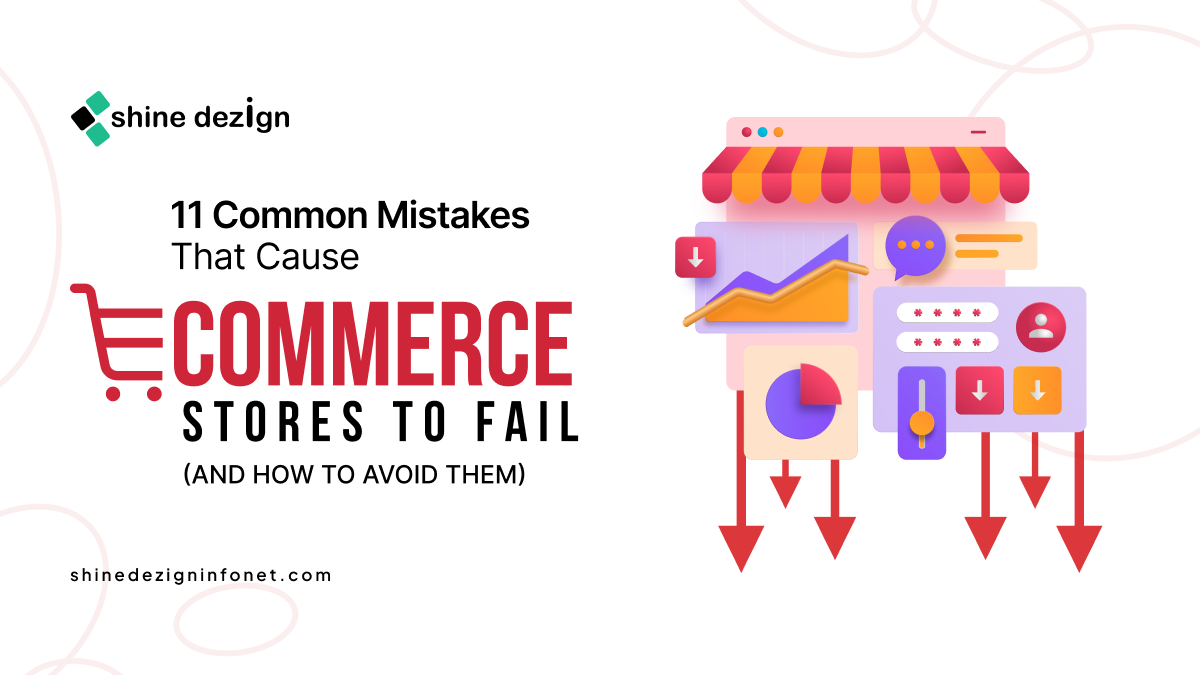Table of Contents
eCommerce has allowed us to opt for all the things we need in just few taps. Moreover, the eCommerce industry has helped most entrepreneurs to start their online businesses. But most of them are still struggling to make their business successful.
If you are also one struggling to make your eCommerce business more successful. In this blog, we will explore 11 common mistakes that may lead to the failure of your Shopify store.
Why is it vital to avoid Common Mistakes in eCommerce?
 Eleanor Roosevolt would always say, “Learn from the mistakes of others. You can’t live long enough to make them all yourself”.
Eleanor Roosevolt would always say, “Learn from the mistakes of others. You can’t live long enough to make them all yourself”.
Moreover, small errors can negatively impact client experience, brand reputation and revenue. Let’s check out why it is vital
1. Enhances Client Experience
 Mistakes like slow loading websites, complicated check out process, or unclear product description frustrate clients, leading to abandoned carts and loss of trust. Making sure a seamless shopping experience encourages client retention and loyalty.
Mistakes like slow loading websites, complicated check out process, or unclear product description frustrate clients, leading to abandoned carts and loss of trust. Making sure a seamless shopping experience encourages client retention and loyalty.
2. Protects Brand Reputation
 Errors like poor client services, inconsistent branding or delivery issues can affect your reputation. A negative impression is hard to reverse, specially with the speed at which online reviews and social media feedback spread.
Errors like poor client services, inconsistent branding or delivery issues can affect your reputation. A negative impression is hard to reverse, specially with the speed at which online reviews and social media feedback spread.
3. Increases Conversion Rates
 Addressing issues like poorly optimized mobile websites, lack of payment options, or confusing navigation can significantly boost conversion rate. Avoiding these mistakes makes sure more visitors turn into playing clients.
Addressing issues like poorly optimized mobile websites, lack of payment options, or confusing navigation can significantly boost conversion rate. Avoiding these mistakes makes sure more visitors turn into playing clients.
4. Improving Financial Performance
 Mistakes in pricing strategies, inventory management or marketing campaigns can result in lost sales or wasted budget. Avoiding these obstacles helps maximize profits and ensure better return on investment (ROI)
Mistakes in pricing strategies, inventory management or marketing campaigns can result in lost sales or wasted budget. Avoiding these obstacles helps maximize profits and ensure better return on investment (ROI)
11 Common Mistakes that cause eCommerce Stores to Fail
 1. Poor Website Design and User Experience
1. Poor Website Design and User Experience
A cluttered, unresponsive or slow load website drives client away. Your website is the face of your Ecommerce store. A poorly developed and designed cluttered website turns visitors away quickly. Therefore, shoppers expect websites to load within 2 3 seconds.
Slow speed frustrates users and reduces conversions.
Also, if the users struggle to find products or navigate between pages, they are unlikely to complete a purchase. Moreover, ambiguous or poorly placed CTAs confuse visitors.
Solution:
Invest in professional website design, prioritize site speed, and ensure an intuitive layout. Use tools like Google PageSpeed Insights to analyze performance and improve navigation.
2. Lack of Mobile Optimization
Lack of mobile optimization comes under another eCommerce marketing mistakes. Mobile commerce accounts for a significant portion of online sales. If your website is not optimized for mobile devices, you risk losing a substantial audience. Common issues include:
1. Text and images that don’t adjust to screen sizes.
2. Buttons that are too small to click.
3. Checkout processes that don’t function smoothly on mobile.
Solution:
Use a responsive design to adapt to different screen sizes. Test your site’s performance on mobile devices regularly to identify and fix issues.
3. Ignoring SEO Best Practices
Search Engine Optimization (SEO) plays a critical role in driving organic traffic.
Many e-commerce sites fail to rank on search engines due to:
– Lack of keyword research and poorly optimized product pages.
– Duplicate content, especially in product descriptions.
– Ignoring technical SEO elements like XML sitemaps and meta tags.
Solution:
Conduct keyword research to understand what your audience is searching for. Optimize product descriptions, titles, and meta descriptions. Regularly update your site with high-quality content like blogs and guides.
4. Overlooking Product Photography and Descriptions
Your customers can’t physically interact with products, so visuals and descriptions are their only way to evaluate items. Poor-quality images and vague descriptions lead to low trust and reduced sales.
– Low-quality Images: Grainy or poorly lit photos give a negative impression.
– Generic Descriptions: Failing to highlight key features or benefits can make products seem unappealing.
Solution:
Use high-quality images from multiple angles. Include detailed descriptions that highlight product benefits, specifications, and uses.
5. Complicated Checkout Process
A confusing or lengthy checkout process is a primary reason for cart abandonment. Common issues include:
– Requiring users to create an account before purchase.
– Too many steps in the checkout process.
– Limited payment options.
Solution:
Simplify checkout by allowing guest purchases and reducing the number of steps. Integrate multiple payment methods, including credit cards, digital wallets, and Buy Now, Pay Later options.
6. Inadequate Customer Support
Customers expect prompt and efficient support when they encounter issues. A lack of customer support leads to dissatisfaction and lost sales.
– Delayed Responses: Customers don’t want to wait hours or days for assistance.
– Limited Contact Options: Not offering live chat, email, or phone support can frustrate users.
Solution:
Use live chat software to provide instant support. Create an FAQ section for common questions and ensure customer service is available during peak hours.
7. Ignoring Marketing and Branding
E-commerce success depends heavily on branding and consistent marketing efforts. Stores without a clear brand identity or marketing strategy struggle to gain visibility.
– Lack of Social Media Presence: Not engaging on platforms like Instagram, Facebook, or TikTok limits reach.
– Neglecting Paid Ads: Relying solely on organic traffic reduces opportunities for growth.
Solution:
Build a strong brand identity with a memorable logo, colors, and voice. Use social media to connect with audiences and invest in paid advertising to reach potential customers.
8. Failure to Target the Right Audience
Marketing to the wrong audience is a waste of resources and leads to low conversions. Common mistakes include:
– Broad, untargeted campaigns.
– Ignoring customer data like demographics, preferences, and buying behavior.
Solution:
Identify your target audience through surveys, analytics, and market research. Create buyer personas and tailor marketing campaigns to their preferences.
9. Lack of Trust-Building Features
E-commerce stores that don’t instill trust fail to convert visitors into customers. Factors that undermine trust include:
– No SSL certificate, making the site appear insecure.
– Lack of customer reviews or testimonials.
– Absence of clear return and refund policies.
Solution:
Use HTTPS to secure your site, display customer reviews, and create transparent policies. Adding badges like “Secure Checkout” can reassure shoppers.
10. Improper Inventory Management
Inventory mismanagement frustrates customers and leads to missed sales. Common problems include:
– Overselling products that are out of stock
– Failing to restock popular items in time
Solution:
Use inventory management software to track stock levels and predict demand. Automate alerts for low stock and integrate your inventory system with your e-commerce platform.
11. Neglecting Post-Sale Engagement
Many e-commerce businesses focus only on acquiring new customers, neglecting existing ones. Failing to engage customers after a sale reduces repeat business and loyalty.
– No follow-up communication, like order confirmations or thank-you emails.
– Lack of loyalty programs or exclusive offers for repeat customers.
Solution:
Implement email marketing campaigns to follow up with customer’s post-purchases. Offer personalized recommendations, loyalty discounts, or early access to sales.
Summing Up
Running a successful e-commerce store involves more than just listing products online. It requires careful attention to website design, customer experience, marketing, and operations. By addressing these 11 common mistakes, you can build a thriving e-commerce business. Focus on optimizing your site, engaging your audience, and creating a seamless shopping experience to set yourself apart in a competitive market.


















